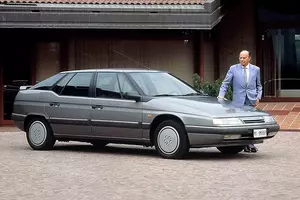
| Vehicle | Curb weight | Difference from world's smallest | Weight to power ratio | 0—60 mph acceleration ratio | Consumption ratio |
|---|---|---|---|---|---|
| 3.0 V6 |
1532 kg / 3378 lbs |
1107 kg (2441 lbs) heavier | 9 kg to 1 hp | 147 kg/s (324 lbs/s) | - |
| 2.1 TD 12V |
1517 kg / 3345 lbs |
1092 kg (2408 lbs) heavier | 14 kg to 1 hp | 123 kg/s (271 lbs/s) | - |
| 2.0 Turbo |
1525 kg / 3363 lbs |
1100 kg (2426 lbs) heavier | 10 kg to 1 hp | 153 kg/s (337 lbs/s) | - |
| 2.0 i 16V |
1467 kg / 3235 lbs |
1042 kg (2298 lbs) heavier | 11 kg to 1 hp | 131 kg/s (289 lbs/s) | - |
| 2.5 TD |
1640 kg / 3616 lbs |
1215 kg (2679 lbs) heavier | 13 kg to 1 hp | 132 kg/s (291 lbs/s) | - |
| Vehicle | 3.0 V6 |
|---|---|
| Curb weight |
1532 kg / 3378 lbs |
| Difference from world's smallest | 1107 kg (1107 lbs) heavier |
| Weight to power ratio | 9 kg to 1 hp |
| 0—60 mph acceleration ratio | 147 kg/s (324 lbs/s) |
| Consumption ratio | - |
| Vehicle | 2.1 TD 12V |
| Curb weight |
1517 kg / 3345 lbs |
| Difference from world's smallest | 1092 kg (1092 lbs) heavier |
| Weight to power ratio | 14 kg to 1 hp |
| 0—60 mph acceleration ratio | 123 kg/s (271 lbs/s) |
| Consumption ratio | - |
| Vehicle | 2.0 Turbo |
| Curb weight |
1525 kg / 3363 lbs |
| Difference from world's smallest | 1100 kg (1100 lbs) heavier |
| Weight to power ratio | 10 kg to 1 hp |
| 0—60 mph acceleration ratio | 153 kg/s (337 lbs/s) |
| Consumption ratio | - |
| Vehicle | 2.0 i 16V |
| Curb weight |
1467 kg / 3235 lbs |
| Difference from world's smallest | 1042 kg (1042 lbs) heavier |
| Weight to power ratio | 11 kg to 1 hp |
| 0—60 mph acceleration ratio | 131 kg/s (289 lbs/s) |
| Consumption ratio | - |
| Vehicle | 2.5 TD |
| Curb weight |
1640 kg / 3616 lbs |
| Difference from world's smallest | 1215 kg (1215 lbs) heavier |
| Weight to power ratio | 13 kg to 1 hp |
| 0—60 mph acceleration ratio | 132 kg/s (291 lbs/s) |
| Consumption ratio | - |

| Vehicle | Curb weight | Difference from world's smallest | Weight to power ratio | 0—60 mph acceleration ratio | Consumption ratio |
|---|---|---|---|---|---|
| 3.0 V6 |
1550 kg / 3418 lbs |
1125 kg (2481 lbs) heavier | 8 kg to 1 hp | 194 kg/s (428 lbs/s) | - |
| 2.1 TD 12V |
1442 kg / 3180 lbs |
1017 kg (2243 lbs) heavier | 13 kg to 1 hp | 117 kg/s (258 lbs/s) | - |
| 2.0 Turbo |
1401 kg / 3089 lbs |
976 kg (2152 lbs) heavier | 10 kg to 1 hp | 159 kg/s (351 lbs/s) | - |
| 2.0 i 16V |
1395 kg / 3076 lbs |
970 kg (2139 lbs) heavier | 11 kg to 1 hp | 135 kg/s (298 lbs/s) | - |
| 2.5 TD |
1564 kg / 3449 lbs |
1139 kg (2512 lbs) heavier | 12 kg to 1 hp | 136 kg/s (300 lbs/s) | - |
| 3.0 V6 24V |
1500 kg / 3308 lbs |
1075 kg (2371 lbs) heavier | 8 kg to 1 hp | 183 kg/s (404 lbs/s) |
132 kg/L (291 lbs/L) |
| Vehicle | 3.0 V6 |
|---|---|
| Curb weight |
1550 kg / 3418 lbs |
| Difference from world's smallest | 1125 kg (1125 lbs) heavier |
| Weight to power ratio | 8 kg to 1 hp |
| 0—60 mph acceleration ratio | 194 kg/s (428 lbs/s) |
| Consumption ratio | - |
| Vehicle | 2.1 TD 12V |
| Curb weight |
1442 kg / 3180 lbs |
| Difference from world's smallest | 1017 kg (1017 lbs) heavier |
| Weight to power ratio | 13 kg to 1 hp |
| 0—60 mph acceleration ratio | 117 kg/s (258 lbs/s) |
| Consumption ratio | - |
| Vehicle | 2.0 Turbo |
| Curb weight |
1401 kg / 3089 lbs |
| Difference from world's smallest | 976 kg (976 lbs) heavier |
| Weight to power ratio | 10 kg to 1 hp |
| 0—60 mph acceleration ratio | 159 kg/s (351 lbs/s) |
| Consumption ratio | - |
| Vehicle | 2.0 i 16V |
| Curb weight |
1395 kg / 3076 lbs |
| Difference from world's smallest | 970 kg (970 lbs) heavier |
| Weight to power ratio | 11 kg to 1 hp |
| 0—60 mph acceleration ratio | 135 kg/s (298 lbs/s) |
| Consumption ratio | - |
| Vehicle | 2.5 TD |
| Curb weight |
1564 kg / 3449 lbs |
| Difference from world's smallest | 1139 kg (1139 lbs) heavier |
| Weight to power ratio | 12 kg to 1 hp |
| 0—60 mph acceleration ratio | 136 kg/s (300 lbs/s) |
| Consumption ratio | - |
| Vehicle | 3.0 V6 24V |
| Curb weight |
1500 kg / 3308 lbs |
| Difference from world's smallest | 1075 kg (1075 lbs) heavier |
| Weight to power ratio | 8 kg to 1 hp |
| 0—60 mph acceleration ratio | 183 kg/s (404 lbs/s) |
| Consumption ratio |
132 kg/L (291 lbs/L) |

| Vehicle | Curb weight | Difference from world's smallest | Weight to power ratio | 0—60 mph acceleration ratio | Consumption ratio |
|---|---|---|---|---|---|
| 2.0 i |
1380 kg / 3043 lbs |
955 kg (2106 lbs) heavier | 11 kg to 1 hp | 111 kg/s (245 lbs/s) |
152 kg/L (335 lbs/L) |
| 2.1 D 12V |
1380 kg / 3043 lbs |
955 kg (2106 lbs) heavier | 17 kg to 1 hp | 76 kg/s (168 lbs/s) |
200 kg/L (441 lbs/L) |
| 2.0 i Turbo CT |
1500 kg / 3308 lbs |
1075 kg (2371 lbs) heavier | 10 kg to 1 hp | - |
165 kg/L (364 lbs/L) |
| 2.1 TD 12V |
1455 kg / 3208 lbs |
1030 kg (2271 lbs) heavier | 13 kg to 1 hp | 118 kg/s (260 lbs/s) |
220 kg/L (485 lbs/L) |
| 3.0 i V6 |
1505 kg / 3319 lbs |
1080 kg (2382 lbs) heavier | 9 kg to 1 hp | 145 kg/s (320 lbs/s) |
152 kg/L (335 lbs/L) |
| Vehicle | 2.0 i |
|---|---|
| Curb weight |
1380 kg / 3043 lbs |
| Difference from world's smallest | 955 kg (955 lbs) heavier |
| Weight to power ratio | 11 kg to 1 hp |
| 0—60 mph acceleration ratio | 111 kg/s (245 lbs/s) |
| Consumption ratio |
152 kg/L (335 lbs/L) |
| Vehicle | 2.1 D 12V |
| Curb weight |
1380 kg / 3043 lbs |
| Difference from world's smallest | 955 kg (955 lbs) heavier |
| Weight to power ratio | 17 kg to 1 hp |
| 0—60 mph acceleration ratio | 76 kg/s (168 lbs/s) |
| Consumption ratio |
200 kg/L (441 lbs/L) |
| Vehicle | 2.0 i Turbo CT |
| Curb weight |
1500 kg / 3308 lbs |
| Difference from world's smallest | 1075 kg (1075 lbs) heavier |
| Weight to power ratio | 10 kg to 1 hp |
| 0—60 mph acceleration ratio | - |
| Consumption ratio |
165 kg/L (364 lbs/L) |
| Vehicle | 2.1 TD 12V |
| Curb weight |
1455 kg / 3208 lbs |
| Difference from world's smallest | 1030 kg (1030 lbs) heavier |
| Weight to power ratio | 13 kg to 1 hp |
| 0—60 mph acceleration ratio | 118 kg/s (260 lbs/s) |
| Consumption ratio |
220 kg/L (485 lbs/L) |
| Vehicle | 3.0 i V6 |
| Curb weight |
1505 kg / 3319 lbs |
| Difference from world's smallest | 1080 kg (1080 lbs) heavier |
| Weight to power ratio | 9 kg to 1 hp |
| 0—60 mph acceleration ratio | 145 kg/s (320 lbs/s) |
| Consumption ratio |
152 kg/L (335 lbs/L) |

| Vehicle | Curb weight | Difference from world's smallest | Weight to power ratio | 0—60 mph acceleration ratio | Consumption ratio |
|---|---|---|---|---|---|
| 2.0 i TCT |
1400 kg / 3087 lbs |
975 kg (2150 lbs) heavier | 10 kg to 1 hp | 151 kg/s (333 lbs/s) |
157 kg/L (346 lbs/L) |
| 2.0 i |
1310 kg / 2889 lbs |
885 kg (1952 lbs) heavier | 11 kg to 1 hp | 116 kg/s (256 lbs/s) |
149 kg/L (329 lbs/L) |
| 2.1 D 12V |
1305 kg / 2878 lbs |
880 kg (1941 lbs) heavier | 16 kg to 1 hp | 78 kg/s (172 lbs/s) |
195 kg/L (430 lbs/L) |
| 2.1 TD 12V |
1380 kg / 3043 lbs |
955 kg (2106 lbs) heavier | 13 kg to 1 hp | 112 kg/s (247 lbs/s) |
209 kg/L (461 lbs/L) |
| 3.0 i V6 24V |
1475 kg / 3252 lbs |
1050 kg (2315 lbs) heavier | 7 kg to 1 hp | 180 kg/s (397 lbs/s) |
145 kg/L (320 lbs/L) |
| 3.0 i V6 |
1420 kg / 3131 lbs |
995 kg (2194 lbs) heavier | 8 kg to 1 hp | 154 kg/s (340 lbs/s) |
148 kg/L (326 lbs/L) |
| Vehicle | 2.0 i TCT |
|---|---|
| Curb weight |
1400 kg / 3087 lbs |
| Difference from world's smallest | 975 kg (975 lbs) heavier |
| Weight to power ratio | 10 kg to 1 hp |
| 0—60 mph acceleration ratio | 151 kg/s (333 lbs/s) |
| Consumption ratio |
157 kg/L (346 lbs/L) |
| Vehicle | 2.0 i |
| Curb weight |
1310 kg / 2889 lbs |
| Difference from world's smallest | 885 kg (885 lbs) heavier |
| Weight to power ratio | 11 kg to 1 hp |
| 0—60 mph acceleration ratio | 116 kg/s (256 lbs/s) |
| Consumption ratio |
149 kg/L (329 lbs/L) |
| Vehicle | 2.1 D 12V |
| Curb weight |
1305 kg / 2878 lbs |
| Difference from world's smallest | 880 kg (880 lbs) heavier |
| Weight to power ratio | 16 kg to 1 hp |
| 0—60 mph acceleration ratio | 78 kg/s (172 lbs/s) |
| Consumption ratio |
195 kg/L (430 lbs/L) |
| Vehicle | 2.1 TD 12V |
| Curb weight |
1380 kg / 3043 lbs |
| Difference from world's smallest | 955 kg (955 lbs) heavier |
| Weight to power ratio | 13 kg to 1 hp |
| 0—60 mph acceleration ratio | 112 kg/s (247 lbs/s) |
| Consumption ratio |
209 kg/L (461 lbs/L) |
| Vehicle | 3.0 i V6 24V |
| Curb weight |
1475 kg / 3252 lbs |
| Difference from world's smallest | 1050 kg (1050 lbs) heavier |
| Weight to power ratio | 7 kg to 1 hp |
| 0—60 mph acceleration ratio | 180 kg/s (397 lbs/s) |
| Consumption ratio |
145 kg/L (320 lbs/L) |
| Vehicle | 3.0 i V6 |
| Curb weight |
1420 kg / 3131 lbs |
| Difference from world's smallest | 995 kg (995 lbs) heavier |
| Weight to power ratio | 8 kg to 1 hp |
| 0—60 mph acceleration ratio | 154 kg/s (340 lbs/s) |
| Consumption ratio |
148 kg/L (326 lbs/L) |